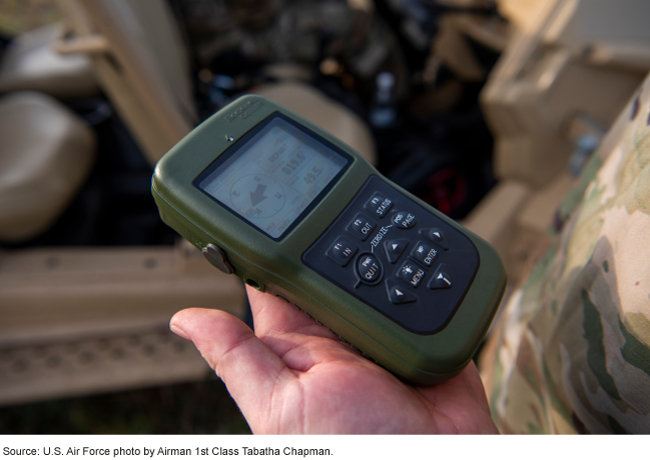GPS Modernization: Delays Continue in Delivering More Secure Capability for the Warfighter
Fast Facts
DOD has been working for years to upgrade GPS with a military-specific signal known as M-code that resists interference or jamming.
Amid ongoing delays, DOD has made some progress developing the necessary ground, space, and user equipment to use M-code. But DOD faces challenges with all 3 segments.
For example, the ground segment modernization finished some key testing, but more testing and demonstration are needed before the system will be ready for use. And, the Air Force's development of receivers that process M-code has been delayed. So, DOD hasn't been able to make sure these receivers work in the places where they'll be used, like planes.

Highlights
What GAO Found
The Department of Defense (DOD) has worked for more than 2 decades to modernize its GPS with a more secure, jam-resistant, military-specific signal known as M-code. The Space Force, part of the Department of the Air Force, is responsible for GPS modernization. The GPS system consists of three segments that cooperate to provide M-code: a space segment, a ground control segment, and user equipment.
After multiple delays, the Space Force has continued its GPS modernization efforts, but significant work and challenges remain for each segment:
- The space segment has mitigated some technical and manufacturing challenges. But in doing so, the Space Force has consumed schedule margin, resulting in potential delays to delivering the satellites. Further delays could risk DOD's goal to have 24 M-code-capable satellites in continuous operation through the 2030s.
- After multiple delays, ground segment modernization has completed some key testing, but further testing and demonstration is needed before the military departments can accept the system. This is projected to occur by December 2025.
- While the Space Force has made progress in developing user equipment, significant risks remain to delivering capabilities to the warfighter. After years of delay, the first increment of user equipment—microchips and cards that process M-code signals—is approaching its final series of tests. However, discovery of additional deficiencies threatens the program's schedule. Meanwhile, DOD is addressing potential shortages of GPS chips and cards.
GPS User Equipment Integration

The military uses receivers in vehicles, munitions, and handheld devices to receive and process GPS data. The Air Force has been delayed in integrating M-code with its receivers. But the other departments are making progress.
- To mitigate some of these delays, the Navy and Air Force are planning an interim solution that could provide limited M-code capability for aircraft.
- The Army plans to field receivers in its platforms in fiscal years 2024 and 2025.
- The Navy plans to complete operational testing of its maritime receiver in fiscal year 2025.
Why GAO Did This Study
GPS is the principal source of positioning, navigation, and timing information for the U.S. military and its partners. The Air Force launched the first GPS satellite capable of broadcasting the more jam-resistant M-code signal in 2005. Continued delays to the ground and user equipment segments, however, prevent widespread use of the technology. Integration of the user equipment with ground, air, and maritime weapon systems by the military departments is critical to delivering this capability to the warfighter. GAO has reported on challenges DOD experienced developing these systems since 2009 and made many recommendations to improve those efforts. For example, DOD has implemented eight of nine recommendations since 2022.
Congress included a provision for GAO to assess the cost, schedule, and performance of GPS acquisition programs. This report assesses (1) the progress the Space Force has made in modernizing GPS space and ground control segments; (2) the extent to which the Space Force has identified and managed risks in developing and demonstrating user equipment; and (3) the extent to which the military departments have identified and managed risks in acquiring, testing, and fielding M-code-capable user equipment.
GAO reviewed pertinent documentation, such as contract performance reports, and interviewed relevant officials from DOD and the military departments. DOD provided technical comments, which we incorporated as appropriate
For more information, contact Jon Ludwigson at (202) 512-4841 or ludwigsonj@gao.gov.
